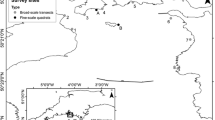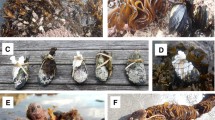Synopsis
At an offshore reef near Santa Barbara, southern California, young-of-year (‘young’) of five surfperch species (Embiotocidae: Embiotoca jacksoni, E. lateralis, Hypsurus caryi, Rhacochilus toxotes, Damalichthys vacca) once thrived in a dense kelp understory of Pterygophora californica and Laminaria farlowii, but disappeared after a severe storm in February, 1980 deforested their habitat. Measurements of fish density and kelp cover made before deforestation indicated that the young surfperch appeared in the spring and disappeared in the fall as cover increased and declined. Adult surfperch and large kelp bass (Paralabrax clathratus), which can eat young but not adult surfperch, remained all year. We tested to see if kelp cover was an essential refuge for the young by pruning back (‘thinning’) kelp blades from one of two transects. The thinning caused a significant redistribution of young which clearly avoided open spaces, but not of adults which are less vulnerable to predation. Measurements of fish density made after the storm-induced deforestation showed that adult surfperch and kelp bass still remained abundant even after the young surfperch were gone. Only after an abrupt reforestation in 1983, more than a year after the present study was terminated, were young once again seen on the reef. Although young surfperch may seek tiny prey living on kelp blades, most lines of evidence indicated that the distribution of the young is more a response to risk of predation. Hence the extent of kelp understory was probably the main determinant of the survival of young surfperch on the reef.
Similar content being viewed by others
References cited
Baltz D.M. 1984. Life history variation among female surfperches (Perciformes: Embiotocidae). Env. Biol. Fish. 10: 159–171.
Barney, R.L. & B.J. Anson. 1920. Life history and ecology of the pigmy sunfish, Elassoma zonatum. Ecology 1: 241–256.
Bowen, S.H. & B.R. Allanson. 1982. Behavioral and trophic plasticity of juvenile Tilapia mossambica in utilization of the unstable littoral habitat. Env. Biol. Fish. 7: 357–362.
Bray, R.N. & M.A. Hixon. 1978. Night-shocker: predatory behavior of the Pacific electric ray (Torpedo californica). Science 200: 333–334.
Cooper, W.E. & L.B. Crowder. 1979. Patterns of predation in simple and complex environments. pp. 257–267. In: R.H. Stroud & H. Clepper (ed.) Predator-Prey Systems in Fisheries Management, Sport Fishing Institute, Washington, D.C.
Crowder, L.B. & W.E. Cooper. 1982. Habitat structural complexity and the interaction between bluegills and their prey. Ecology 63: 1802–1813.
Duncan, D.B. 1955. Multiple range and multiple F tests. Biometrics 11: 1–42.
Ebeling, A.W. & R.N. Bray. 1976. Day versus night activity of reef fishes in a kelp forest off Santa Barbara, California. U.S. Fish. Bull. 74: 703–717.
Ebeling, A.W., R.J. Larson, W.S. Alevizon & R.N. Bray. 1980. Annual variability of reef-fish assemblages in kelp forests off Santa Barbara, California. U.S. Fish. Bull. 78: 361–377.
Ellison, J.P., C. Terry & J.S. Stephens Jr. 1979. Food resource utilization among five species of embiotocids at King Harbor, California with preliminary estimates of caloric intake. Mar. Biol. 52: 161–169.
Errington, P.L. 1934. Vulnerability of bobwhite populations to predation. Ecology 15: 110–127.
Errington, P.L. 1945. Some contributions of a fifteen-year local study of the northern bobwhite to a knowledge of population phenomena. Ecol. Monogr. 15: 1–34.
Fraser, D.F. & R.D. Cerri. 1982. Experimental evaluation of predator-prey relationships in a patchy environment: consequences for habitat use patterns in minnows. Ecology 63: 307–313.
Gerard, V.A. 1976. Some aspects of material dynamics and energy flow in a kelp forest in Monterey Bay, California. Ph.D. Dissertation, University of California, Santa Cruz. 173 pp.
Gerking, S.D. 1957. A method of sampling the littoral macrofauna and its application. Ecology 38: 219–225.
Glass, N.R. 1971. Computer analysis of predation energetics in the largemouth bass. pp. 325–363. In: B.C. Patten (ed.) Systems Analysis and Simulation in Ecology, Vol I, Academic Press, New York.
Green, R.H. 1979. Sampling design and statistical methods for environmental biologists. John Wiley & Sons, New York. 257 pp.
Grossman, G.E. 1980. Ecological aspects of ontogenetic shifts in prey size utilization in the bay goby (Pisces: Gobiidae). Oecologia 47: 233–238.
Grossman, G.E., R. Coffin & P.B. Moyle. 1980. Feeding ecology of the bay goby (Pisces: Gobiidae). Effects of behavioral, ontogenetic, and temperal variation on diet. J. Exp. Mar. Biol. Ecol. 44: 47–59.
Hall, D.J. & E.E. Werner. 1977. Seasonal distribution of fishes in the littoral zone of a Michigan lake. Trans. Amer. Fish. Soc. 106: 545–555.
Helfman, G.S. 1981. The advantage to fishes of hovering in shade. Copeia 1981: 392–400.
Hixon, M.A. 1980 Competitive interactions between California reef fishes of the genus Embiotoca. Ecology 61: 918–931.
Holbrook, S.J. & R.J. Schmitt. 1984. Experimental analysis of patch selection by foraging black surfperch (Embiotoca jacksoni). J. Exp. Mar. Biol. Ecol. (in press).
Jackson, P.B.N. 1961. The impact of predation especially by the tiger fish (Hydrocynus vittatus Cast) on African freshwater fishes. Proc. Zool. Soc. Lond. 136: 603–622.
Keast, A. 1978. Trophic and spatial interrelationships in the fish species of an Ontario temperate lake. Env. Biol. Fish. 3: 7–31.
Keast, A., J. Harker & D. Turnbull. 1978. Nearshore fish habitat utilization and species associations in Lake Opinicon (Ontario, Canada). Env. Biol. Fish. 3: 173–184.
Kramer, C.Y. 1956. Extension of multiple range tests to group means with unequal numbers of replications. Biometrics 12: 307–310.
Laur, D.R. & A.W. Ebeling. 1983. Predator-prey relationships in surfperches. Env. Biol. Fish. 8: 217–229.
Love, M.S. & A.W. Ebeling. 1978. Food and habitat of three switch-feeding fishes in the kelp forests off Santa Barbara, California. U.S. Fish. Bull. 76: 257–271.
Magnuson, J.J., L.B. Crowder & P.A. Medvick. 1979. Temperature as an ecological resource. Amer. Zool. 19: 331–343.
Mittelbach, G.G. 1981. Foraging efficiency and body size: a study of optimal diet and habitat use by bluegills. Ecology 62: 1370–1386.
Robertson, D.R. & S.A. Foster. 1982. Off-reef emigration of young adults of the labrid fish Epibulus insidiator. Copeia 1982: 227–229.
Schmitt, R.J. & J.A. Coyer. 1982. The foraging ecology of sympatric marine fish in the genus Embiotoca (Embiotocidae): importance of foraging behavior in prey size selection. Oecologia 55: 369–378.
Schmitt, R.J. & S.J. Holbrook. 1984. Ontogenetic shift in the diet of black surfperch, Embiotoca jacksoni (Pisces: Embiotocidae): the roles of fish morphology, foraging behavior, and patch selection. Mar. Ecol. Prog. Ser. (in press).
Sokal, R.R. & F.J., Rohlf. 1981. Biometry, 2nd Ed. W.H. Freeman, San Francisco. 859 pp.
Stein, R.A. 1979. Behavioral response of prey to fish predators. pp. 343–353. In: R.H. Stroud & H. Clepper (ed.) Predator-Prey Systems in Fisheries Management, Sport Fishing Institute, Washington, D.C.
Terry, C.B. & J.S., Stephens Jr. 1976. A study of the orientation of selected embiotocid fishes to depth and shifting seasonal vertical temperature gradients. Bull. So. Calif. Acad. Sci. 75: 170–183.
Author information
Authors and Affiliations
Rights and permissions
About this article
Cite this article
Ebeling, A.W., Laur, D.R. The influence of plant cover on surfperch abundance at an offshore temperate reef. Environ Biol Fish 12, 169–179 (1985). https://doi.org/10.1007/BF00005148
Received:
Accepted:
Issue Date:
DOI: https://doi.org/10.1007/BF00005148




